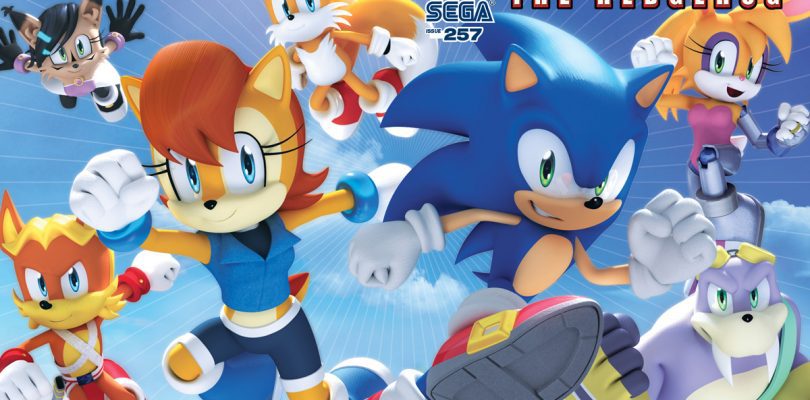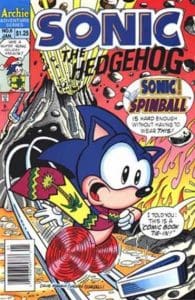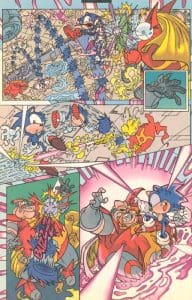From November 22, 1992 to July 19, 2017, for 24 years, Archie Comics has published Sega’s Sonic the Hedgehog. 290 issues in the main book, and with the extra tie-in books over 500 issues in total. With the recent decision by Sega to take their license to IDW from now on, the Archie Sonicverse leaves behind a legacy as not only the longest running comic based on a video game character, but the longest running American comic to have never had a relaunch. With the beloved cast and their stories now up in the air, questions hanging over whether IDW will continue them or just start fresh, I figured now is as good a time as any to remember this book fondly.
The Goofy Beginning
When the book started, it was roughly around the same time as the two animated series were being developed. As a result, it featured both the cast of the popular Sonic SatAM cartoon, but had the same goofy humor as Adventures of Sonic the Hedgehog. This was basically a transitional period as the staff got a handle on the characters, the tone, and exactly what kind of book it was going to be. As the book went on, it slowly started to match the tone of the SatAm series, while still occasionally getting a few good jokes in. Beyond the main cast of Sonic, Robotnik, Sally and the gang, new characters were being added in, both from the cartoon’s second season and original characters like Geoffrey St. John (a shady skunk spy who acted as romantic competition to Sonic for Sally), Anti-Sonic (an evil version of our hero who would eventually just adopt the name Scourge the Hedgehog), Mammoth Mogul (essentially an evil immortal and this book’s version of DC’s Vandal Savage) and Robo-Robotnik (a fully robotic version of the villain, who will play a major role in the later part of the book). It also kept adapting the classic games into the story, introducing Knuckles (who’d get his own spinoff that some could say would lead the biggest controversy in the book’s history) and forming its own lore. The comic was slowly developing the identity that would make fans for the next two decades.
The Golden Age: Mecha Madness, Endgame and Beyond
One of the highpoints in my fandom for this comic was Mecha Madness, a story that started in the main book and concluded in an awesome one-shot special. Sonic gets turned into a robot by Robotnik and is sent to destroy his friends, leading to a battle with Bunnie Rabbot and Knuckles, who allows the Freedom Fighters to turn him into a robot with a free mind to battle the now Mecha Sonic. This was a big turning point in the book, with the stories now becoming more serialized as they continued building towards big payoffs. The most significant of this was Endgame, a story that ran from issues 47 to 50. Sonic is framed for the murder of his beloved Sally, a plan by Robotnik to finally get rid of the hero and destroy all his foes. The climax features one of the best fights of the series as a grief-stricken Sonic and an insane Robotnik battle to the death as the villain’s final weapon consumes the base around them.
In the aftermath, Sally survived, Robotnik was dead at last, and the Freedom Fighters had to figure out how to fix their world now that the planet was free. This was one of the more interesting periods in the book, as there were no new games at the time (the Dreamcast and Sonic Adventure weren’t out yet). Sonic and Tails would embark on a world tour, expanding the lore of the series, and battle Naugus, a villainous sorcerer from the cartoon who became a major threat in the absence of a big bad. So many of the more insane add-on characters would be added during this period, like Monkey Khan (a cyborg monkey who was an expy of the Monkey King from the Chinese epic Journey to the West… this book was insane at times). But eventually, as the games began coming out again with the Dreamcast, the comics had to follow suit. Robo-Robotnik appeared, taking the original’s place, with a new body based on the modern game’s design, and started calling himself Dr. Eggman. This is where the book began to suffer, as it tried to mix its own lore and characters with the new games, which had full voice acting and cutscenes. It led to a divide in the fandom between comic fans and game fans, and as new games came out and new writers came with their own original ideas, the stories kept bouncing back and forth between trying to be faithful to the games and faithful to their own continuity. It was a head scratching time for all involved.
Ian Flynn brings balance, and Ken Penders causes chaos over his Knuckles characters
I truly envy Ian Flynn. The guy, like me, grew up with these comics and games, and had ideas for stories for the book. The difference is that he actually got to write for the book. Flynn managed to balance all the original characters of the book with the games, making for great and interesting stories. Of particular highlight is Genesis, where Eggman’s attempt to rewrite history using the eponymous Genesis Wave gives us a flashback story version of the classic games with the Freedom Fighters included, and its immediate follow-up, where Sally is turned into Mecha-Sally, and made a major villain throughout the continuing story of this timeline. Unfortunately, there was a real-world problem for the book, and his name is Ken Penders.
Penders was a writer/artist on the books, in particular during the build-up to Endgame and the Knuckles spinoff. The spinoff book focused on Knuckles’ adventures with his team, the Chaotix, and started going nuts with building on his own lore, particularly a fully-fleshed out family tree, his parents being alive (thus negating the one constant in the games and comics, his status as last of the Echidnas as well as Guardian of the Floating Island and its Master Emerald), tons and tons of side characters, including a love interest named Julie-Su, it was insane. The problem happened when Penders attempted to sue Sega for characters created for the Nintendo DS RPG Sonic Chronicles: the Dark Brotherhood, claiming they ripped off his creations. This of course makes no sense, as Sega owns the comics and its characters. Except that when Archie and Sega tried to find the paperwork stating that characters created for the Sonic books are owned by the video game corporation, they couldn’t find Penders’. It should be noted that it’s widely accepted by fans and some professionals that Penders stole the paperwork when he left. As a result of this, his lawsuit caused a massive problem for the books. Sega decided to scrap any and all characters in the comic that they didn’t own outright, so as to avoid a similar problem. Penders, seemingly content with this, currently is trying to get his original comic with all his created Sonic characters going, despite the fact that it still looks like a Sonic book no matter how he claims it’s so original. As for the actual comic, they needed a way to soft reboot everything. And once again, Ian Flynn came to the rescue.
Worlds Collide, and a New Beginning
Flynn was, coincidentally, also the writer on Archie’s Mega Man comics, and he started from around the time of the Genesis storyline laying the groundwork for an epic crossover. Dr. Wily and Eggman make contact with each other, leading to the most awesome evil bromance of all time. They use the Genesis Wave technology to reset their universes to only game continuity (a clever idea, simplifying the cast to only games, given how this book brought game fans in with no prior knowledge) and set about trying to eliminate their heroes. Sonic/Mega Man: Worlds Collide is an epic crossover with tons of great moments, like the Blue Blur and Blue Bomber initially fighting each other, their exploration of a villain lair that is filled with tons of references to final boss lairs from both their games, the two of them and Sonic’s friends battling EVERY ROBOT MASTER FROM MEGA MAN’S HISTORY (I especially love the fight between Sonic and Quick Man)! We even get a showdown of our two heroes against Metal Sonic and Bass before fighting it out with Eggman and Wily. And in the aftermath, Eggman interferes with Sonic’s attempt to restore the comic universe, leading to a soft reboot.
The result of this was that the cast was considerably slimmed down to the original Freedom Fighters and the heroes from the games, and their first order of business: possibly the best adaption you could get for Sonic Unleashed. The massive multipart epic even included a part of the story based on the arcade fighting game Sonic the Fighters, complete with a tournament and everything (the tournament even included appearances by characters from the Adventures cartoon). They even had a sequel to the Mega Man crossover, Worlds Unite, in which all Sonic and Capcom characters teamed up to beat Megaman X villain Sigma. The book was now a great jumping on point for fans of the original cartoon, the games, and those with fond memories of the original comics. And as well as that storyline, there were new specials like Sonic: Mega Drive, which basically adapted the classic games ideas with no comic originals. It was a good time to be a Sonic comic fan.
Sadly, Sega has decided to end the book here, leaving the fate of this version of Sonic and his friends hanging as they get ready for to move their license to IDW.
I don’t usually do this, especially as I doubt Sega, Archie Comics or IDW would ever read this, but I have to say it: Please, if this is the end of this comic’s story and characters, at least collect them in omnibus form for the fans. And IDW and Sega, please, don’t let this be the end of the characters that many fans have grown to love, and can’t imagine a Sonic comic without.
24 years. 290 issues in the main book. 500 issues all including specials and spin-offs. Not bad for a video game comic.









